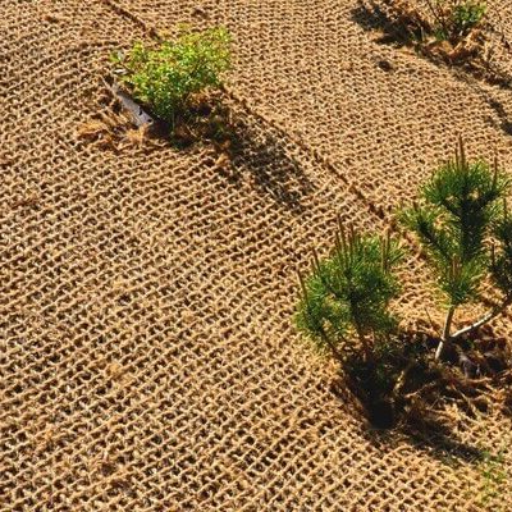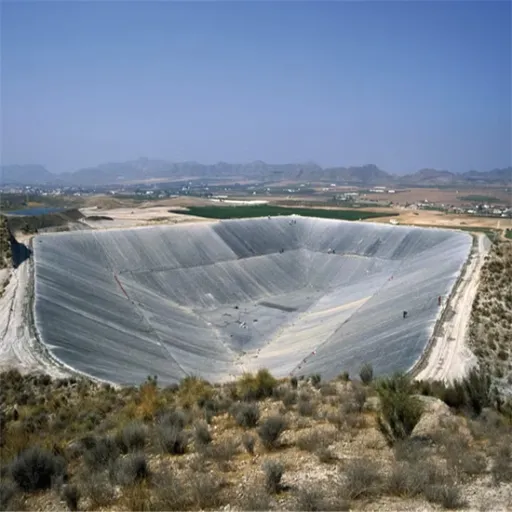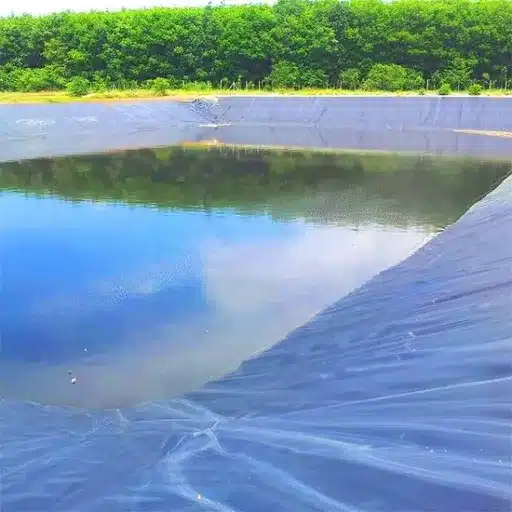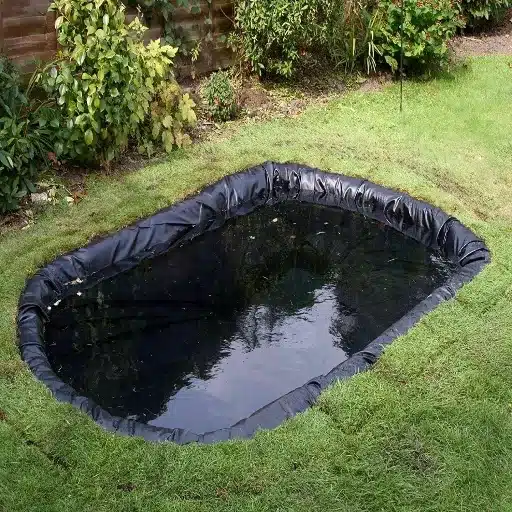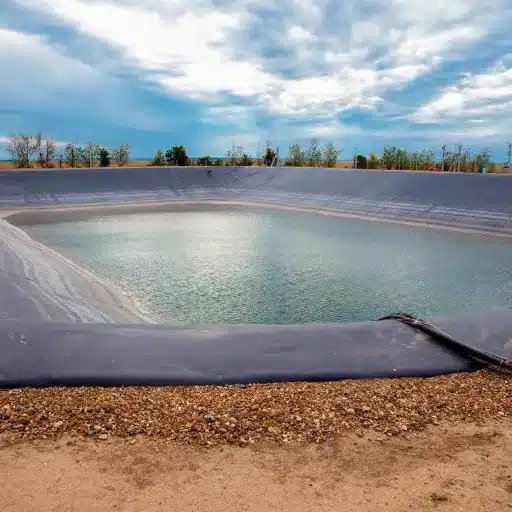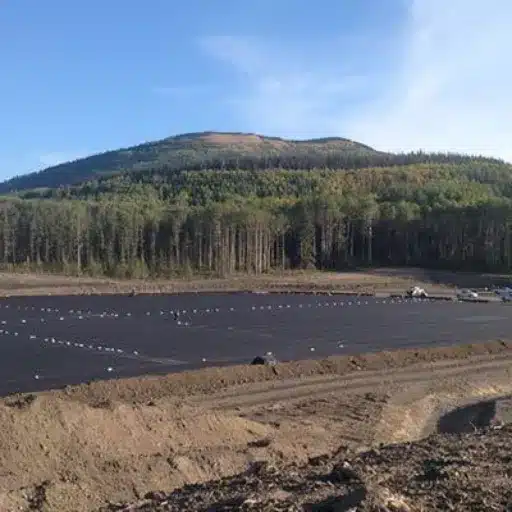Erosion is an entirely natural process; however, when left to its own, it can have extremely damaging effects on landscapes, agriculture, and infrastructure. An eco-friendly approach toward resolving this problem has increasingly become a priority in the world of sustainable practices. Jute mesh netting, therefore, is that innovative, biodegradable material that serves to protect the soil, control erosion, and support vegetation growth-BUT does not harm the environment! This article elaborates on how jute mesh netting is used, its advantages, and why it is a revolutionary approach to erosion control. Whether you have construction sites, agricultural lands, or natural habitat restoration avenues to deal with, discover why jute mesh netting is your most viable option for environmentally-friendly erosion management.
Introduction to Jute for Erosion Control
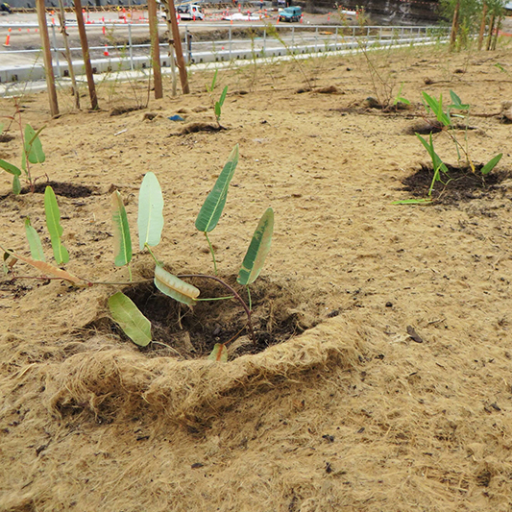
The primary functions of the jute mesh netting are to retain soil, keep water runoff at bay, and nurture the growth of vegetation. As it is biodegradable, it remains in the ecosystem for a certain period of time; hence, it serves as an eco-friendly option for erosion control.
What is Jute Mesh Netting?
Jute mesh netting comprises a biodegradable fabric coming from jute fibers, providing an amicable approach toward soil erosion. This choice of natural material is woven into a coarse and spasmodic open grid pattern that holds soil in place, cuts down on surface runoff, and promotes vegetation establishment. The permeability of the mesh allows the free flow of water while simultaneously stabilizing the substrate and thereby maintaining the ecosystem balance.
Presently, there is information regarding the recognition of the use of jute mesh netting for erosive-prone sites like slopes, riverbanks, and construction sites. Jute mesh netting usually breaks down in one to two years, depending on the environmental conditions, because this period is adequate to provide temporary erosion control. Research has proved that it can lower soil loss by max 68% when compared with bare soil, thus very much favoring land rehabilitation. Also, the jute fibers can absorb 2.5 times their weight in water, thereby retaining moisture for germinating seeds and seedlings.
Jute mesh netting is not only an effective erosion control method but an eco-friendly one, too, containing elements of sustainable development. Jute is a fast-growing natural fiber and requires little or no pesticide or fertilizer. The packaging of jute helps rural economies, mainly in India and Bangladesh, where over 4 million farmers depend on the jute industry. Therefore, jute mesh netting obviously combines practicality and social responsibility in erosion control projects.
Importance of Erosion Control in Landscaping
Maintaining erosion control is, therefore, necessary to conserve soil in landscapes, to avoid soil erosion in lands, and to support vegetation growth in both urban and rural landscapes. The latest data indicate soil erosion to be a worldwide concern, with over 24 billion tons of fertile soil being lost annually to water and wind erosion, hampering agricultural productivity and water quality, as eroded sediments often carry pollutants into rivers and streams.
Prevention of these adverse effects is possible by implementing erosion control measures including the use of jute netting. A recent study undertaken by the United States Department of Agriculture suggests that erosion control methods can minimize soil loss by about 80% in affected areas when introduced into landscaping. These measures placed a premium on implementation of sustainable landscaping with the environment-protecting bead of jute netting, forming resilient ecosystems that are crucial for biodiversity.
Brief Overview of Biodegradable Erosion Control Solutions
Biodegradable erosion control solutions emerged as a sustainable erosion-control measure, improving environmental health. These solutions include coconut coir mats, jute netting, straw blankets, and wood fiber rolls, which decompose over time and do not leave any toxic residues in the environment. They work to stabilize soil, encourage growth of vegetation, and settle in place with natural ecosystems.
Coconut coir mats, for instance, are manufactured from husk fibers of coconut and boast of high tensile strength and work well on steep slopes and areas of heavy water flow. Research actuaries claim the mats can reduce runoff and sediment loads by about 65%, greatly relieving erosion dangers. Similarly, jute netting, which comes from the fibers of the jute plant, is lightweight, cheap, and able to provide crucial support during plant establishment.
Straw blankets are also preferred and common erosion-control materials. They are made from agricultural byproducts and are used to keep soil from being displaced in reforestation projects and construction sites while allowing vegetation to root and stabilize. Such blankets reportedly reduce soil loss by approximately 50% compared to untreated sites.
The giant umbrellas of global environmental policies promoting carbon footprint reductions and renewable resources further back the use of biodegradable erosion control products. Such measures are being promoted as a green initiative combining ecological gain with practical compliance for construction and landscaping projects by a number of governments and organizations worldwide.
Benefits of Jute Mesh for Erosion Control
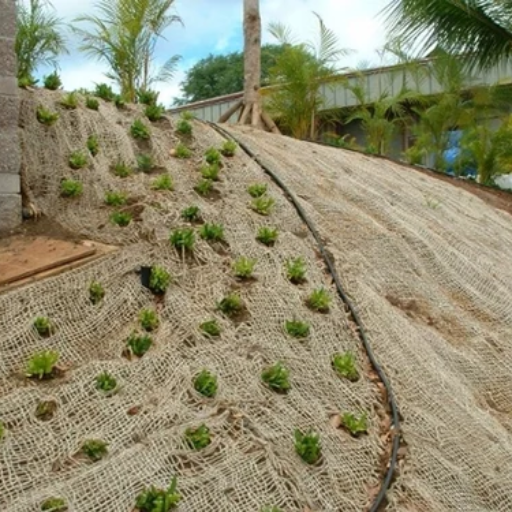
Jute mesh, with its natural properties and benefits to the environment, is one erosion control solution that stands apart. Soil stabilization is provided instantaneously as it helps in keeping the soil water running off and being displaced. On the other hand, the mesh is biodegradable-it decomposes naturally over time and adds nutrients to the soil simultaneously without polluting it. Growing vegetation on the mesh promotes its long-term use, which is environmentally sustainable.
Natural Properties of Jute
Truly, jute is a multipurpose and environment-friendly fiber, much discussed for its natural properties, which make it a sustainable choice in every environmental and industrial setting. One such stunning feature of jute is its high tensile strength, implying that it while being used for purposes such as erosion control and packaging, guarantees that the jute will remain durable and stable. In contrast, it is moisture absorbent, which benefits projects that support vegetation growth like landscaping or soil stabilization.
Another interesting aspect that the fiber offers is its biodegradability. Jute products depart the scene within a year or two after performing their function, leaving not a trace of harmful residues unlike the plastic alternatives that do so. Therefore, it synergizes with global efforts towards reduction of plastic wastes and achieving environmental protection goals. Additionally, jute is a renewable resource and could be harvested in 4-6 months, possibly making jute a fast-growing and inexpensive material.
Recent research shows that jute can absorb and release carbon dioxide more efficiently. One hectare of jute might absorb around 15 tons of CO2 during growth, thus positively supporting the climate change movement. The given attributes, along with affordability, are the reason why many industries are gravitating towards this material as a greener solution.
Effectiveness in Soil Stabilization
In protecting erosion and land degradation-prone areas, jute has gained much credit as a soil stabilizer. Jute fiber is useful as a truly natural geotextile to support soil structure and as a filter to water. According to some studies, jute geotextiles reduce soil erosion by up to 90% in heavy rainfall areas. Since it is also biodegradable, it promotes the health of the soil by improving the soil nutrient content while encouraging sustainable land management. Combining these two functions makes it ideal for environmental conservation works such as in riverbank protection, road construction, and slope stabilization. Some studies suggest that jute geotextiles can keep 12-16% moisture in the soil, which is beneficial for agriculture in dry and semi-dry areas.
Environmental Advantages of Jute Mesh
Jute mesh offers a plethora of environmental benefits that have led it to become the favored material in eco-friendly projects globally. Being natural in origin and biodegradable, it promises that it will fit nicely into an ecosystem without any residue that is harmful to that system. For example, jute mesh decomposes in about 1 to 2 years and in the process helps in enriching the soil with organic matter and fostering biodiversity.
In addition to the presence of jute having a positive impact on the environment, the plants used for its growth possess the ability to withdraw a substantial amount of carbon dioxide from the atmosphere. A study on rotation showed that one hectare of jute absorbs nearly 15 tons of CO2 and then releases nearly 11 tons of oxygen within a period of 100 days during its cultivation. This is greatly helpful in fighting against climate change by reducing greenhouse gas concentrations.
Moreover, this jute mesh has shown extremely positive results in soil erosion control and land restoration. It was recorded that jute geotextiles could reduce rates of erosion by 68% when compared to bare soil while encouraging vegetation growth through moisture retention and substrate stabilization. These benefits are highly beneficial in flood- or desertification-prone regions.
Another factor favoring jute over synthetic alternatives is its requirement of a lower amount of water and chemicals throughout its cultivation. Synthetic alternatives typically are plastic-based materials and environmentally unfriendly in their production methods; in contrast, jute uses fewer pesticides and fertilizers. This means that the practice of cultivation is furthering the cause of environmental conservation, hence aiding in the longer-term balance of ecosystems.
Combined factors coupled with versatility and affordability make the jute mesh a principal tool for projects seeking environmental sustainability, climate change alleviation, and ecosystem restoration.
Applications of Jute Mesh Netting
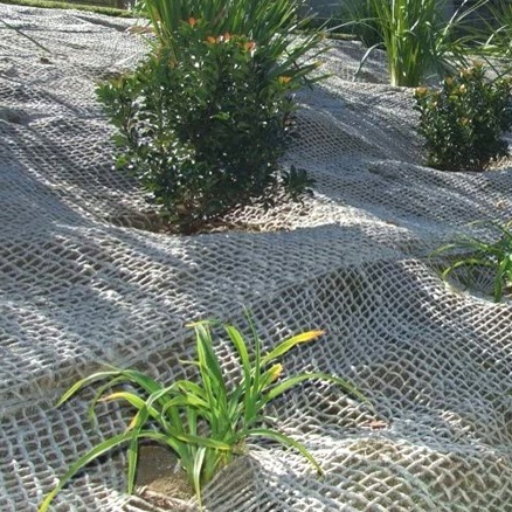
Generally, jute mesh netting is used for soil erosion control, land replantation, vegetable cropping, and so forth. Being biodegradable, it is used for the stabilization of slopes, erosion prevention of soil, and helping seed germination in degraded land. Besides, these nets are also used in landscaping, road construction projects, and riverbank protection because they are environment-friendly and cheaper.
Agricultural Practices
Relying entirely on jute mesh for the implementation of sustainable agriculture becomes especially relevant in concrete regions where soil degradation is accompanied. It has been recently investigated that jute netting cuts down on soil erosion up to 80%, establishing a layer of protection against water runoff and aiding the soil in retaining moisture. The spatial arrangement of jute netting permits water infiltration and aids crop growth by wicking away from the supporting soil top.
As jute netting is biodegradable and disintegrates in the environment within about 6 to 24 months, it enriches the soil in its fecund decomposition. This biodegradability makes it an ideal choice for mulching in organic agriculture where chemical fertilizers and synthetic materials are eschewed. A top agricultural research finds its application in jute mesh on crop land has been able to bring about a 20% increase in yield productivity on degraded lands, thus making a case for sustainable farming solutions.
Landscape Restoration Projects
In the course of the past few decades, landscape restoration has increasingly caught the world’s attention as soil degradation, deforestation, and biodiversity erosion increasingly threaten life. Among these efforts, sustainable techniques like the jute mesh are gradually emerging as one of the pillars for restoring degraded ecosystems. The report issued by UNCCD in 2022 marks that almost 20% of the world’s vegetated land has been degraded and lessening the livelihood of at least 1.5 billion people worldwide. This puts programs such as the Bonn Challenge, whose goal is the restoration of 350 million hectares of degraded land by 2030, right on top of the list for urgent and sustainable solutions.
Since the jute netting is economical, efficient, and environmentally friendly, it remains the means toward restoring this environment. Through afforestation activities, soil stabilization ensures that the young plants and trees have a supportive environment growing around them, thus aiding long-term recovery of vegetation. The World Resources Institute (WRI) has data that show landscapes restored with jute assist in water retention in soil by 30%, making it extremely helpful for fighting wicked drought-prone conditions. On the other hand, jute application to large-scale restoration efforts can minimize the carbon footprint since it undergoes natural decomposition without any synthetic residues.
The world continuingly joins hands alongside the use of materials such as jute mesh in the restoration of landscapes, which in turn fights environmental pressures, in the interim promoting sustainable land use for future generations.
Coastal and Riverbank Protection
The use of natural materials such as jute in coastal and riverbank protection has proved highly effective in promoting erosion and conservation of natural habitats. Coastal erosion affects 70% of all sandy shorelines throughout the world, as are victims of sea-level rise and human exploitation. Within the remit goes matters of utmost urgency for these vulnerable areas, wherein biodegradable geotextiles, such as jute mats, play an intervention.
Jute geotextiles, once placed on soil and sandbanks, take away moisture and nutrients and promote vegetation growth. It is evident from past research that there is up to 95% reduction in erosion within one year since the implementation of jute mat at the sites. In addition, these biodegradable solutions help lessen the impacts of extreme weather events by maintaining soil integrity and allow for the resurgence of natural ecosystems. With initiatives such as Ministry of Jute-supported projects in India, these materials have become widely used for stabilizing riverbanks in the Ganges Basin.
Coastal and riverbank protective measures are thus becoming more sustainable and more pertinent, backed by integrating geotextiles with habitat-friendly engineering techniques and looking into the latest trends in environmental conservation. This highlights the use of natural resources in fighting one of the ever-increasing challenges on the global face.
Comparative Analysis of Erosion Control Methods
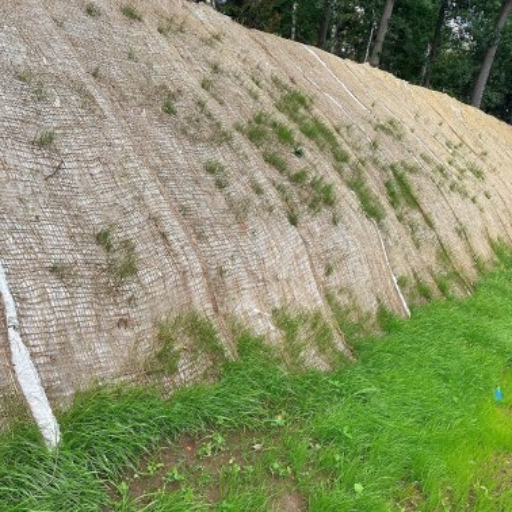
Given a choice when comparing erosion control methods, my preferred ones would have to be those balancing efficacy with environmental sustainability. Geotextiles come about as a good solution owing to their being versatile, environmentally friendly, and timely in restoration of habitats. Unlike the conventional methods, these materials would likely not have adverse effects on nature and provide an effective yet environmentally friendly way for smoothing out riverbanks and coastal lines.
Jute Mesh vs. Synthetic Erosion Control Blankets
Jute mesh and synthetic erosion control blankets differ in their biodegradability, durability, cost, and environmental impact.
| Parameter | Jute Mesh | Synthetic Blankets |
|---|---|---|
| Material | Natural | Synthetic |
| Durability | Moderate | High |
| Cost | Affordable | Varies |
| Lifespan | Short-term | Long-term |
| Eco-Impact | High | Low |
| Installation | Easy | Moderate |
Traditional Methods: Sandbags and Mulch
These two are among the typical, conventional methods of soil erosion and stabilization. Sandbags are used in floods and erosion because they are easy and cheap to use and versatile. Sandbags are usually made of a sturdy fabric like burlap or polypropylene; they may be filled with sand or soil and stacked to form a barrier to divert water flow and prevent sediment displacement. It is said that a standard sandbag holds about 40 pounds of material, thus providing a very quick application of the bag.
Mulch, on the other hand, has a role to assist in soil erosion and can increase fertility. It contains organic materials consisting of wood chips, straw, or bark, which lie on top of the soil and reduce water runoff, temperature shifts, and heat and moisture loss from the soil. Studies have found that the presence of an even layer of mulch, 2 to 3 inches thick, can reduce soil erosion by as much as 85%. Mulch is most effective for limited application scenarios such as gardens and landscaping, and it is often used in concert with other techniques when considering larger or more serious erosion issues. Both methods can work well in certain situations but are often best used as complementary techniques in an integrated erosion control program.
Inexpensiveness of Jute-Based Solutions
Jute is now a viable, inexpensive, and ecological alternative to erosion and soil stabilization. As natural fibers, jute is biodegradable and does not harm the environment, making it most suitable for environmentally conscious endeavors. According to a recent report, jute geotextiles have been observed to reduce soil loss by 40% to 45% within a six-month timeframe, especially in areas prone to heavy rainfall or wind erosion. These textiles facilitate water movement, keeping their soil intact and supporting vegetation growth.
Moreover, jute products remain low in their cost as compared with those of synthetic ones. The average jute geotextile price is $0.40 to $0.80 per square foot, depending on grade and thickness, and thus, usable for both small and large applications. Their proven capabilities and affordability have lent support to jute geotextiles by many governments and environmental agencies for use on highway side slopes, riverbanks, and agricultural lands. Thus, jute solutions not only cut costs but also serve sustainable development objectives within erosion control strategies.
Case Studies and Real-World Examples
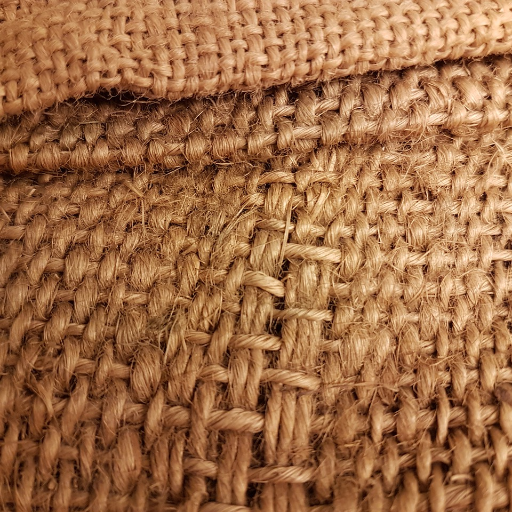
I recommend adopting jute geotextiles for erosion control because they are inexpensive; biodegradable, when compared with synthetic geotextiles, government agencies have approved them for a broader range of applications such as highway slopes and riverbanks. Being cheap and proven in performance for the sustainability projects, they constitute a great option.
[Case Study]: Successful Implementation of Jute
India leads in the use of jute geotextiles in sustainable development projects. One such application is the construction and stabilization of highway slopes in Assam, where the State Government had used jute geotextiles for about 10 kilometers on erosion-prone sites along two major highways. The results have been spectacular, with erosion being checked by over 60% within the first year and vegetation growth being accelerated speedily to aid erosion control in the long run.
There is also a project on the riverbanks of the Brahmaputra where jute geotextiles helped prevent soil loss. As per the research carried out by the Indian Jute industries’ Research Association (IJIRA), the sediment loss was cut to 50 percent over the traditional ones. As such, these measures reduced costs by 30% and improved environmental conservation as the geological measures incorporated biodegradable materials.
The above real-world examples illustrate the clear benefits of jute geotextiles, which represent a critical pathway for sustainable development all over the globe, not only for large civil infrastructure projects but also for environmental restoration.
[Case Study]: Erosion Control for Coastal Areas
Coastal erosion is a significant matter worldwide, with some 70% of the sandy shores all over the globe witnessing a retreat. Elevating sea levels and climate changes coupled with human interferences contribute to the disappearance of coastal ecosystems, infrastructure, and communities. Jute geotextiles are proposed in response to this environmental stress being a sustainable and viable set of remedies.
Data speaks for the feat jute geotextiles have gained at coastal areas. For instance, investigations made in areas like the Sundarbans of India have revealed a reduction in erosion rates by as much as 60% within five years than do areas where conventional measures like hard structures were placed; stabilization of soils and promotion of vegetation growth were key among their achievements. Further evidence came from the Nile Delta in Egypt: the integration of jute geotextiles on erosion control systems raised mangrove survival by 40%, thus forming a natural biological barrier from wave energy and storm surges.
Further analyses expose cost benefits. Generally, jute geotextiles are cheaper, by about 25-30%, than synthetic alternatives, yet are similarly durable and efficient. Such biodegradable fabrics are known to decompose naturally within 1-2 years, thereby contributing to soil organic matter and making waste disposal problems associated with synthetic materials irrelevant. Hence, from a long-term coastal resilience point of view, jute has emerged as a valid, green solution.
Jute geotextiles in combination with plantings promoted by the community and ongoing monitoring are proving most effective in erosion-prone areas. This combination of sustainable solutions presents great economic savings, ecological restoration, and solid community involvement to form a resilient future for coastal zones.
[Expert Quote]: Insights from Industry Experts
According to recent data, the use of jute geotextiles in coastal restoration projects has shown very impressive results. Studies indicate that jute geotextiles reduce soil erosion by up to 60% while also enhancing the growth of vegetation in dune and shoreline locations. Evidence from worldwide case studies, which include projects in India and Bangladesh, highlights the use of biodegradable materials that can blend well with existing ecosystems as environmentally friendly options.
Experts also emphasize community involvement as a critical success factor for these projects. Data from the 2022 Environmental Coastal Research Institute bibliography suggest that areas that combined jute geotextiles with community-driven planting initiatives achieved a vegetation density twice as high as those in areas that employed traditional restoration techniques alone. These restoration projects protect the coastline while simultaneously empowering local communities through participation in decision-making and the provision of job opportunities.
If future coastal resilience can be backed with such sound data-driven measures, alongside sustainable materials and local efforts, both ecology and the economy stand to be well served.
Reference sources
1. Effect of Parameters on the Runoff Erosion Control Performance of Structurally Modified Jute and Coir Geomeshes over Loamy Sand
- Authors: S. Verma, V. Midha, A. Choudhary
- Publication Date: March 27, 2021
- Journal: TEKSTILEC
- Citation Token: (Verma et al., 2021)
- Summary: This study investigates the performance of modified jute and coir geomeshes in controlling runoff erosion on loamy sand at various slope angles. The research found that slope angle significantly affects erosion control, with the twill-woven structure of coir geomeshes performing better at lower angles, while plain-woven jute geomeshes excelled at higher angles. The study also included germination tests to assess the impact of geomeshes on vegetation growth.
- Methodology: The authors conducted laboratory experiments to test the geomeshes under controlled conditions, varying slope angles and measuring runoff erosion control performance. They also performed germination tests to evaluate the effectiveness of the geomeshes in promoting plant growth.
2. Denudation Control of Embankment Slope Configuration Using Jute Geo Textiles
- Author: M. Mamatha
- Publication Date: August 30, 2017
- Journal: International Journal for Research in Applied Science and Engineering Technology
- Citation Token: (Mamatha, 2017, pp. 1363–1370)
- Summary: This paper discusses the use of jute geotextiles to control soil erosion on embankments and hilly slopes, particularly in tropical regions. The study highlights the effectiveness of jute geotextiles in providing temporary reinforcement until vegetation can establish itself, thus preventing soil erosion.
- Methodology: The research involved field studies where jute geotextiles were applied to embankment slopes. The effectiveness of these materials was assessed based on their ability to reduce soil erosion and promote vegetation growth over time.
3. The effectiveness of jute and coir blankets for erosion control in different field and laboratory conditions
- Authors: Jana Kalibová, L. Jačka, J. Petrů
- Publication Date: March 30, 2016
- Journal: Solid Earth
- Citation Token: (Kalibová et al., 2016, pp. 469–479)
- Summary: This study evaluates the performance of jute and coir erosion control blankets under various laboratory and field conditions. The results indicated that both materials significantly reduced soil erosion, with jute blankets showing superior performance in certain conditions.
- Methodology: The authors conducted experiments in both controlled laboratory settings and natural field conditions, measuring runoff and soil loss to compare the effectiveness of jute and coir blankets.
Frequently Asked Questions (FAQs)
What is a jute mesh erosion control and how does it work?
The control of erosion using jute mesh describes the mechanism for soil erosion protection through the use of blankets made of jute fiber. Natural erosion control solutions stabilize the soil and encourage growth of grass and other ground covers by allowing water and nutrients to reach the soil while shielding it from other elements.
How long does a jute mesh last for erosion control?
A jute mesh is meant for temporary erosion control-from 6 months to 2 years maximum, subject to environmental modifications! Once used in an erosion control system, jute meshes biodegrade, turning back into the soil.
Are DIY projects in landscaping with jute netting possible?
Yes, jute netting is ideal for DIY projects in landscaping. It can be used as an anti-weed cover, preventing undesirable weeds while still letting grass grow through it. The netting can also be held down by landscape staples or sod staples.
Is jute mesh used in applications for yard drainage?
Jute mesh can stabilize soil and improve water retention as it pertains to yard drainage. Because of its flexible nature, it allows for proper drainage conditions and prevents erosion, making it a perfect selection for areas with heavy water runoff.
How does sandbaggy jute netting compare with the conventional landscape fabric?
Sandbaggy jute netting is manufactured from natural jute fibers; thus, it is beneficial to Nature when compared with synthetic landscape fabric. Both act as soil erosion barriers, but jute netting biodegrades as time passes, enhancing the soil, whilst synthetic fabric may take forever to degrade.
What are the benefits that come with jute mesh usage for erosion control?
Jute mesh for erosion control offers various benefits including the growth of grass or vegetation, its biodegradable nature, and causing erosion control in most landscapes. Another advantage is that it has a natural look that blends well with the environment.
How do I apply jute mesh for optimum erosion control?
Proper installation of jute mesh begins with preparing the area by removing debris from the surface and leveling the soil. After one lays the jute mesh over the place, landscape staples or sod staples should be used to secure it to the ground. Ensure that the mesh is in good contact with the soil-it will provide for better erosion control and vegetation growth.
Can erosion control jute mesh be used for sloping?
Yes, jute mesh can be used for erosion control, especially on slopes, with its limited loose weave to allow for soil retention and drainage. With proper installation, jute mesh on a slope superintend erosion over downhill and the growth of grass and other plants.

